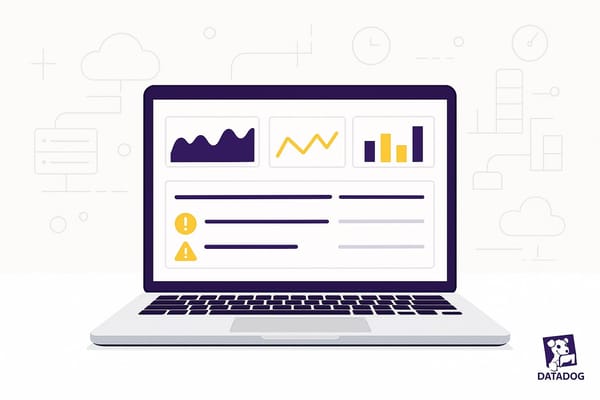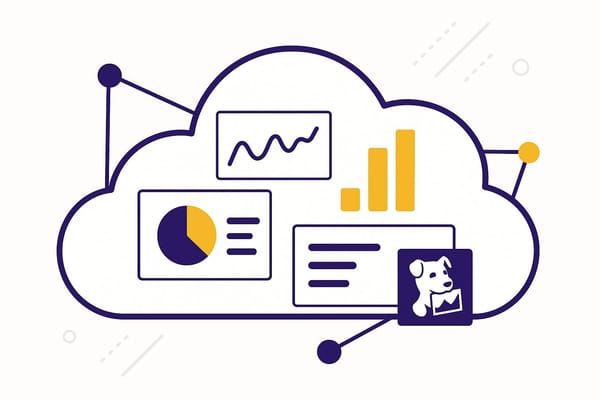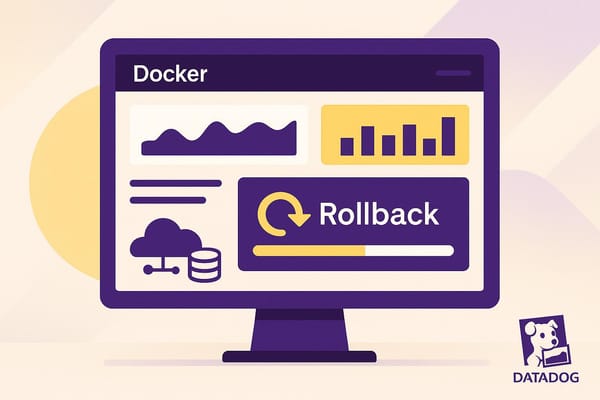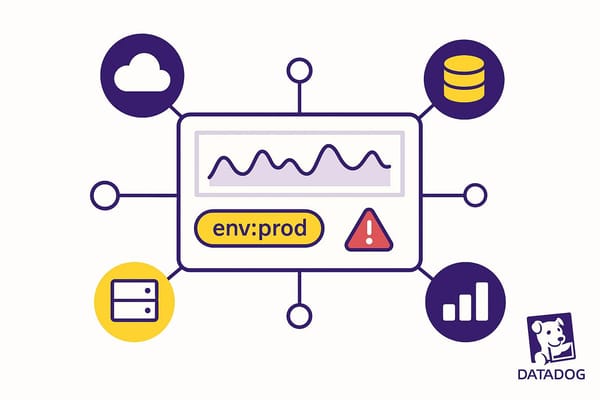Ultimate Guide to API Security Monitoring with Datadog
With API breaches on the rise, SMBs face significant risks. Learn how to enhance API security using effective monitoring and protection strategies.
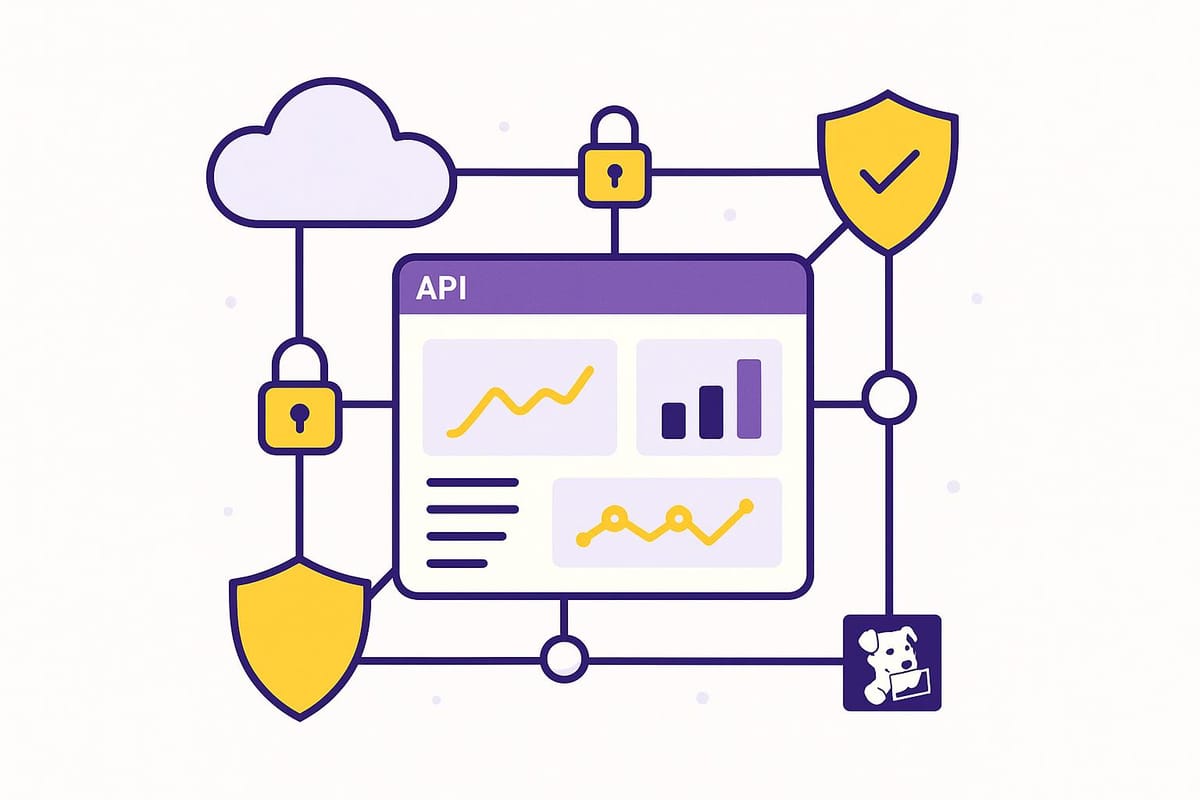
API breaches are on the rise, increasing by 117% in 2022, and SMBs are particularly vulnerable. Without proper security measures, businesses risk financial losses, operational downtime, and damage to customer trust. Datadog offers tools to help SMBs secure their APIs, detect threats in real time, and simplify monitoring.
Key Takeaways:
- API Risks for SMBs: Common vulnerabilities include weak authentication, data exposure, and lack of rate limiting.
- Impact of Breaches: Average costs range from $826 to $653,587, with 60% of SMBs shutting down within six months of an attack.
- Datadog Features:
- API Security Inventory: Automatically discovers and catalogs API endpoints.
- Threat Detection: Identifies unusual traffic patterns and blocks threats in real time.
- Custom Monitoring Rules: Tailor alerts for specific risks like failed logins or suspicious IP activity.
- Best Practices: Use encryption, implement MFA, manage API endpoints, and set up rate limiting.
Datadog simplifies API security for SMBs, offering enterprise-grade tools to protect sensitive data and maintain customer trust. Start by focusing on your most critical APIs to prevent breaches and ensure business continuity.
Application Security Management Demo
API Security Risks and Challenges for SMBs
Small and medium-sized businesses (SMBs) face unique challenges when it comes to API security. APIs are the backbone of today's digital economy, but they’ve also become prime targets for cybercriminals. Why? Because SMBs are often seen as easier targets compared to larger enterprises with more fortified networks. This evolving threat landscape makes it essential to understand common vulnerabilities and the potential business impacts of API breaches.
Common API Vulnerabilities
SMBs often struggle with some key API security gaps, including weak authentication, data exposure, and poor rate limiting. Here’s what these vulnerabilities look like in practice:
- Broken Authentication: Many SMBs rely on basic username-password setups without adding multi-factor authentication (MFA), leaving systems open to attacks.
- Data Exposure: Misconfigured APIs can unintentionally reveal sensitive internal details, making them easy pickings for attackers.
- Lack of Rate Limiting: Without controls to limit the number of API requests, businesses risk denial-of-service (DoS) attacks or brute-force attempts.
The numbers paint a stark picture. Employees at SMBs are 350% more likely to face social engineering attacks compared to those at larger enterprises. On top of that, small businesses receive malicious emails at an alarming rate - one in every 323 emails is a threat. These attacks often aim to steal API credentials or access tokens, making strong API security not just a best practice but a necessity for survival.
Business Impact of API Breaches
The fallout from an API breach can be devastating for SMBs. Financially, the cost of a breach can range anywhere from $826 to a staggering $653,587 on average. And the consequences go beyond just dollars and cents - 60% of SMBs that experience a cyberattack shut down within six months.
Operational downtime is another major blow. Half of SMBs report that recovering from a cyberattack takes at least 24 hours. For businesses that depend on APIs for critical functions like customer service, payment processing, or inventory management, even a single day of downtime can have catastrophic ripple effects. Then there’s the damage to customer trust: over half of U.S. consumers (55%) say they’d be less likely to continue doing business with a company that has suffered a breach.
"Small businesses have plenty of customer information - like credit card numbers, email addresses, and insurance details - that are enticing to cyber criminals." - Verizon
The reality is, SMBs are targeted for a reason. A whopping 87% of small businesses store customer data that could be compromised in an attack. Yet, despite this, 51% of SMBs operate without any cybersecurity measures in place.
Core Security Concepts for APIs
To tackle these challenges, SMBs need to understand and apply fundamental API security principles.
- Authentication and Authorization: Authentication confirms a user’s identity, while authorization determines what actions that user can perform. Implementing MFA and adhering to the principle of least privilege - granting users only the access they absolutely need - can significantly reduce risks.
- Attack Surface Management: SMBs should identify and secure all API endpoints, including any undocumented or "shadow APIs" that may exist.
- Data Protection: Encrypting sensitive data is critical. Using TLS (Transport Layer Security) protects data in transit, while encrypting stored data helps guard against unauthorized access, even if systems are breached.
- Rate Limiting and Throttling: These mechanisms help control the number of API requests, preventing abuse and protecting server resources - an especially important safeguard for SMBs with limited infrastructure.
However, implementing these measures isn’t always straightforward for SMBs. Nearly half (47%) of businesses with fewer than 50 employees have no budget for cybersecurity, and 59% believe they’re too small to be targeted. To bridge these gaps, regular audits, penetration testing, and having a clear incident response plan are essential.
These core concepts highlight the importance of comprehensive monitoring tools, like those offered by Datadog, to help SMBs address these challenges head-on. By adopting a proactive approach, SMBs can better protect their APIs and, ultimately, their businesses.
Datadog API Security Monitoring Features
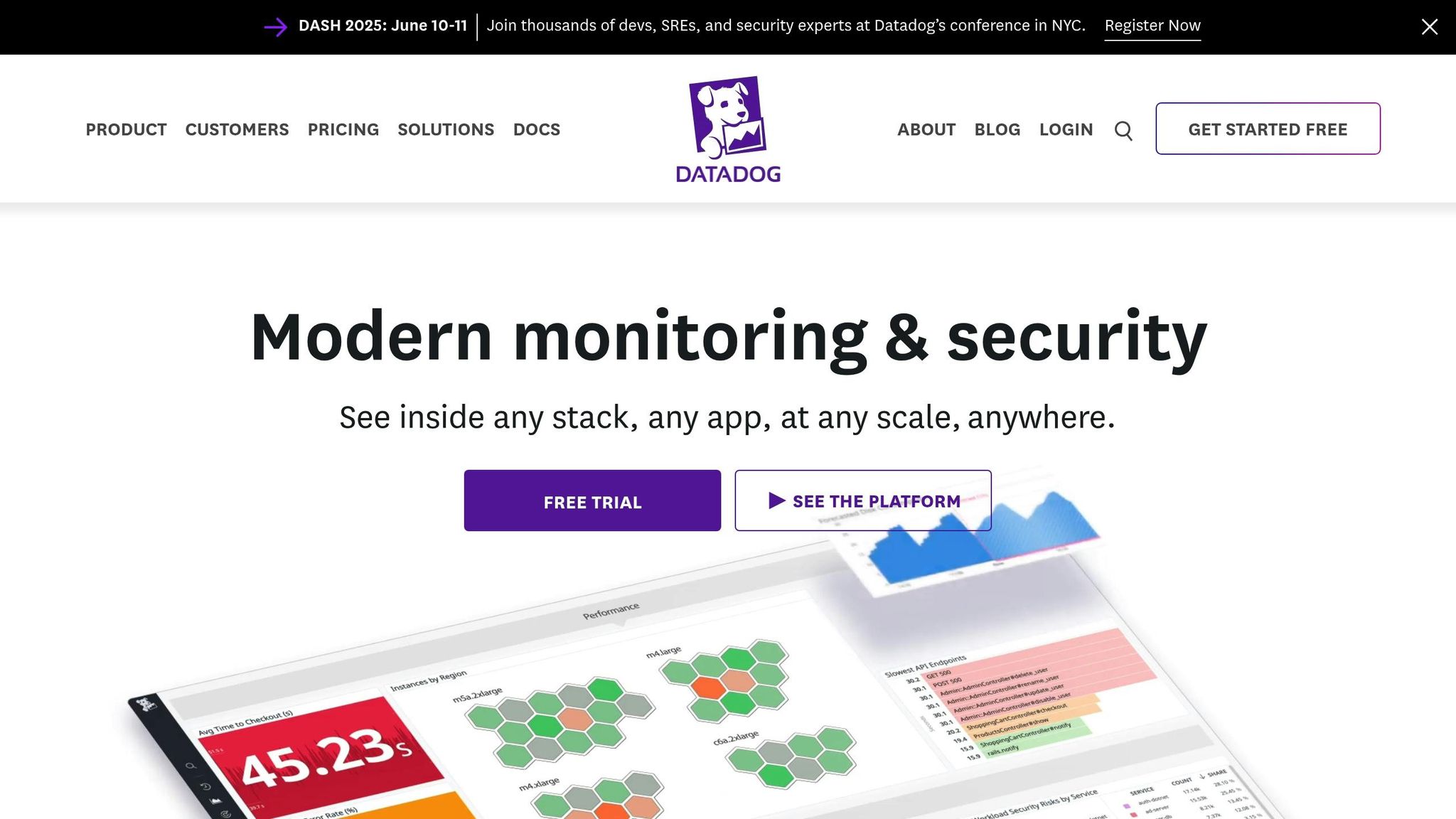
Datadog's API security tools are designed to safeguard APIs for small and medium-sized businesses (SMBs) against evolving threats while simplifying operational workflows.
API Security Inventory
The API Security Inventory offers comprehensive visibility into your API ecosystem by automatically discovering and cataloging endpoints across your infrastructure. It maps API traffic, identifies active endpoints, and flags potential risks. This feature tracks API usage metrics, such as which endpoints handle the most traffic, where requests originate, and how data flows through your system. For businesses managing multiple applications, a centralized dashboard consolidates key metrics like response times, error rates, and security indicators. Additionally, it monitors API versioning and flags outdated or deprecated endpoints, helping maintain a secure and efficient API environment.
Threat Detection and App Protection
Datadog’s App and API Protection (AAP) provides real-time monitoring of vulnerabilities across web and serverless applications by using APM traces and code context. The system analyzes incoming requests, comparing them against known attack patterns. When suspicious activity is detected, Datadog can automatically block the request or flag it for review. This ensures rapid responses, even for organizations without a dedicated 24/7 security team.
"Datadog helps us detect attacks against our serverless applications, and triggers an automated response to block those attempts as they happen. App and API Protection was simple to enable." - Micha Katz, CISO, Yellow Card
The platform also uses a Severity Score to prioritize vulnerabilities. This score considers factors such as exposure, CVSS ratings, and real-time threat activity. Additionally, the platform offers end-to-end visibility into open-source libraries across CI pipelines and production environments, enabling teams to identify and address security gaps before they escalate.
Custom Security Monitoring Rules
Custom security monitoring rules allow SMBs to tailor API monitoring to address their specific threat landscape. These rules can detect a variety of issues, from unusual traffic patterns to specific attack signatures. Datadog provides multiple detection methods that can be combined for a robust monitoring approach:
| Detection Method | Description |
|---|---|
| Threshold | Flags patterns of suspicious activity. |
| Anomaly | Detects unusual system behavior. |
| New Value | Identifies unexpected changes. |
| Impossible Travel | Alerts on logins from geographically impossible locations. |
| Third Party | Tracks alerts from partner systems. |
Effective alert configuration is critical for incident response. Different alert levels are tied to specific trigger conditions and response actions:
| Alert Level | Trigger Conditions | Response Actions |
|---|---|---|
| Warning | 3–5 failed login attempts | Slack notification |
| Critical | 10+ failed attempts or suspicious IP activity | Slack, Email, and Ticket creation |
| Emergency | Detected data breach attempt | All channels plus auto-remediation |
The success of custom rules relies on smart thresholding - adjusting alert triggers based on historical data instead of generic defaults. Integrating multiple data streams, such as logs, cloud services, and application metrics, further strengthens threat detection. This approach is particularly effective at identifying complex attacks that might bypass single-point monitoring.
Next, we’ll dive into how to set up these features in Datadog for a more secure API environment.
Setting Up API Security Monitoring in Datadog
Getting started with API security monitoring in Datadog involves a structured approach, beginning with discovery and protection phases. This setup ensures a comprehensive security monitoring framework.
Adding APIs to Datadog
The API Catalog in Datadog acts as the backbone of your security monitoring system by automatically identifying and cataloging API endpoints. Using distributed tracing, it maps out production endpoints across your infrastructure, creating a centralized API inventory.
To enrich this data, you can upload OpenAPI specification files, which Datadog integrates with existing tracing telemetry and metadata. This automation eliminates the need to manually register endpoints - Datadog detects them as traffic flows through your systems.
To begin, you'll need two keys: an API Key for sending metrics and events, and an Application Key for managing APIs. Make sure to store these securely and rotate them periodically.
The API Explorer is a powerful tool for visualizing how endpoints connect, analyzing traffic patterns, and identifying undocumented APIs that could pose security risks. This helps ensure compliance with internal policies and security standards. Additionally, the API Explorer allows you to set up custom alerts based on service level objectives, helping you address performance issues in critical API endpoints before they escalate [26, 25].
Once your APIs are cataloged, the next step is to configure security rules that turn data into actionable alerts.
Configuring Security Rules and Alerts
At the heart of Datadog's security monitoring are Cloud SIEM detection rules, which analyze ingested logs to identify potential threats in real time. You can use both built-in and custom detection rules to fit your specific environment.
Detection rules are built using key log attributes, allowing for highly granular configurations. Datadog provides five detection methods, each tailored to different scenarios:
| Detection Method | Use Case | Configuration Focus |
|---|---|---|
| Threshold | Monitor API call volumes and error rates | Define baseline limits for normal activity |
| Anomaly | Spot unusual behavior patterns | Set learning periods for typical operations |
| New Value | Detect unexpected API endpoints or parameters | Specify acceptable ranges for changes |
| Impossible Travel | Flag suspicious geographic access patterns | Configure realistic travel time constraints |
| Third Party | Integrate external security alerts | Set up connections with partner systems |
Security signals provide detailed insights into flagged activities, and you can customize these messages using template variables to include key attributes and dynamic links. Datadog assigns severity levels and prioritizes alerts using conditional logic for logs that match detection rules.
To reduce false positives, you can use suppression lists. These lists might include safe users, services, or processes that are known to operate within your environment. For example, if an AWS CloudTrail API call triggers an alert - such as making an Amazon EC2 AMI public - you can verify its legitimacy and add it to a suppression list to avoid future alerts.
Once your security rules are fine-tuned, you can expand monitoring across your entire infrastructure using Datadog’s integrations.
Connecting Datadog to Existing Infrastructure
Datadog offers seamless integration with existing infrastructure through programmatic API configurations. You can connect Datadog to platforms like AWS, Slack, PagerDuty, and custom webhooks to streamline alerting and incident response.
For example, custom webhooks can trigger specific actions based on Datadog alerts, such as initiating automated remediation scripts or sending tailored notifications. This ensures quick and effective incident response, which is especially critical for small and medium-sized businesses. Additionally, you can use the Datadog API to automate monitoring and alert configurations as your infrastructure evolves.
To maintain smooth operations, implement error handling to prevent Datadog API issues from disrupting your primary API functionality. Use caching to reduce API calls, manage rate limits with backoff and retry logic, and organize metrics efficiently with a comprehensive tagging system.
Best Practices for API Security Monitoring with Datadog
Keeping your API secure isn’t just a technical necessity - it’s a critical part of maintaining trust and meeting regulatory standards. With Datadog, you can take a structured approach to monitoring, combining proactive security measures, actionable insights, and compliance alignment to protect your systems effectively.
Finding and Fixing Vulnerabilities
The first step in securing your APIs is staying ahead of potential threats. Regularly monitor Common Vulnerabilities and Exposures (CVEs) and consult resources like the NIST database to identify emerging risks.
Datadog’s App and API Protection (AAP) simplifies this process by automating security rule creation, flagging suspicious activities, and tracking security events. It’s a powerful tool for identifying vulnerabilities before they become critical issues.
To get a clear picture of your attack surface, use tools like code scanning, software bills of materials (SBOMs), and Datadog’s Service Catalog. The Service Catalog acts as a centralized hub, mapping all your services and their associated vulnerabilities. This makes it easier to stay organized and proactive.
Datadog Workflows take it a step further by automating vulnerability analysis. Workflows can collect and analyze vulnerability data automatically, reducing the manual effort required to keep up with new threats.
When incidents occur, Datadog Incident Management streamlines your response. By integrating with tools like Slack and mobile apps, you can coordinate responses, manage triage, delegate tasks, and monitor progress - all in real time. Flagging credible threats as incidents and sharing findings ensures everyone involved is informed and ready to act.
Strengthen your defenses further by enforcing robust authentication protocols (like OAuth2 and OpenID Connect) and applying strict authorization controls. Adopting the principle of least privilege and implementing rate limiting can also prevent denial-of-service attacks and limit resource misuse.
Using Datadog’s Security Insights Tools
Datadog’s suite of security tools provides deep visibility into how your APIs are performing and where vulnerabilities might exist. For example, the API Explorer allows you to correlate traffic patterns with security events. This feature can help you uncover undocumented APIs that could pose risks and ensure compliance with internal security policies.
Custom monitors are another essential tool. These can alert you to performance anomalies that might signal security issues. Addressing these deviations early can prevent them from escalating into bigger problems.
With Application Security Management (ASM) integration, security teams can analyze your API ecosystem’s exposure to attacks directly within Datadog. ASM can even block suspicious IP addresses in real time, offering immediate protection against threats.
Distributed tracing is another powerful feature. By mapping the entire request flow through your systems, you can identify where security controls might be bypassed or where sensitive data could be at risk.
Finally, configure data retention policies to meet regulatory requirements while retaining enough historical data for effective security analysis. Datadog’s flexible retention settings allow you to strike the right balance between compliance, operational needs, and cost considerations.
Meeting U.S. Compliance Requirements
A solid API security strategy isn’t complete without addressing U.S. compliance requirements. Aligning your practices with these standards strengthens your defenses and ensures you’re prepared for audits.
Start by documenting and categorizing all existing APIs using frameworks like the OpenAPI specification. This helps you maintain detailed records of API endpoints, their functions, and the data they handle. Automated discovery tools within Datadog can also identify APIs you might have missed, closing potential compliance gaps.
For compliance frameworks that require a full inventory of systems processing regulated data, Datadog’s API cataloging features are invaluable. They automatically track and document endpoints, ensuring nothing slips through the cracks.
When it comes to specific regulations like HIPAA, extra precautions are necessary for APIs handling protected health information. This includes enhanced logging, stricter access controls, and encryption measures that go beyond standard security practices.
For GDPR, focus on APIs processing personal data of EU residents. These APIs need to support consent mechanisms, data subject rights, and breach notification protocols.
Financial regulations like SOX and PCI DSS bring their own requirements. APIs handling financial data should have additional monitoring in place, such as transaction logging and fraud detection. Regular security assessments are also critical for demonstrating compliance.
Finally, configure web application firewalls (WAFs) to block suspicious IPs and implement geo-blocking where needed. Document these configurations to provide evidence during audits. Regular penetration testing and security assessments of API endpoints further demonstrate your commitment to maintaining a secure and compliant environment.
Benefits and Challenges of Datadog API Security Monitoring for SMBs
Using Datadog for API security monitoring comes with a mix of advantages and hurdles, especially for small and medium-sized businesses (SMBs). Striking the right balance is key to protecting your APIs effectively.
Weighing the Benefits and Challenges
The numbers are staggering: 99% of organizations reported API security issues last year, leading to $87 billion in losses globally. Experts project that figure could climb to $100 billion by 2026. For SMBs, this highlights just how critical it is to choose the right security monitoring solution.
| Aspect | Benefits | Challenges |
|---|---|---|
| Visibility & Discovery | Automated discovery helps identify "shadow" APIs you might not even know exist. | Setting up requires time to map existing services and organize APIs using OpenAPI specs. |
| Threat Detection | Real-time monitoring utilizes five detection methods (Threshold, Anomaly, New Value, Impossible Travel, Third Party). | Fine-tuning alert thresholds and configuring custom rules can be time-intensive. |
| Integration Capabilities | Over 800 built-in integrations provide extensive system visibility and connect seamlessly with your infrastructure. | Aligning these integrations with your current systems takes effort upfront. |
| Cost Considerations | A centralized platform reduces the reliance on multiple tools and scales with business growth. | Initial setup, training, and subscription costs may strain budgets, especially for simpler API setups. |
These trade-offs emphasize the careful evaluation SMBs must undertake when adopting Datadog for API security.
Datadog's automated discovery is particularly useful given that 27% of organizations reported over 100% API growth, while 25% experienced growth exceeding 50%. This rapid expansion makes uncovering hidden APIs critical.
Real-time monitoring is another standout feature of Datadog. Martyn Davies, a Developer Advocate, underscores its importance:
"Your API security strategy needs real-time monitoring, or it simply isn't a strategy at all. Without real-time API security monitoring, you're essentially leaving your door unlocked and hoping nobody tries the handle."
Still, SMBs face resource constraints and must ensure robust security practices, such as implementing OAuth2, OpenID Connect, strict access controls, and rate limiting. Datadog's tools can complement these efforts, but the learning curve is something to consider.
The financial aspect also varies. For SMBs with rapidly growing APIs, the investment in Datadog often pays for itself by preventing breaches and minimizing manual oversight. However, smaller businesses with simpler API ecosystems may find the upfront costs harder to justify.
To maximize Datadog's potential, evolve your alert system from basic thresholds to smarter, data-driven thresholds using historical patterns and suppression lists. This takes time but significantly improves efficiency.
Start by focusing on your most critical APIs - those with the highest data sensitivity or business value. Strengthen security on these endpoints first, then expand coverage as your team becomes more comfortable with the platform. This step-by-step approach helps manage costs and complexity while protecting your most important assets.
Datadog's comprehensive API security tools provide SMBs with a solid foundation to enhance their resilience in an increasingly digital landscape.
For additional insights and practical advice tailored to SMBs, check out Scaling with Datadog for SMBs.
Conclusion
Protecting your APIs isn't just a technical detail - it's a survival tactic for SMBs in today’s digital-first world. With cyber threats on the rise and the cost of breaches climbing, having a solid API security plan is no longer optional for businesses operating online.
That’s where Datadog steps in. It offers a practical, budget-friendly solution designed specifically for SMBs. Features like automated API discovery help you uncover hidden risks, while real-time threat detection ensures you can address issues before they spiral out of control.
The first step? Focus on your most critical APIs - those that manage sensitive customer data or power your essential business functions. Using Datadog's centralized logging, you can establish a baseline for normal API behavior, making it easier to detect unusual activity that might signal an attack.
Datadog’s monitoring tools don’t just stop at detection; they provide layered protection to greatly reduce your exposure to risks. As of 2021, over 50% of organizations reported facing at least one API-related security threat. With threats only growing more complex, a proactive approach to securing your APIs is essential for staying ahead.
As your business grows - whether by adding services, partnering with others, or entering new markets - your security measures need to keep pace. Datadog’s platform scales alongside your business, giving you the visibility and control needed to maintain strong defenses while supporting expansion.
By leveraging Datadog’s tools, you’re not just reacting to threats; you’re building a security framework that evolves with your business. This approach helps you maintain trust with your customers, meet regulatory requirements, and lay the groundwork for secure digital growth. In a world where connectivity drives success, safeguarding your APIs means safeguarding your future.
For more guidance tailored to SMBs, visit Scaling with Datadog for SMBs.
FAQs
How does Datadog's API Security Inventory help SMBs monitor and secure their API endpoints?
Datadog's API Security Inventory takes the hassle out of managing APIs for small and medium-sized businesses (SMBs). It automatically finds and catalogs every API endpoint in your environment, giving you a clear picture of your API ecosystem while helping to spot potential security vulnerabilities.
The tool keeps an eye on API traffic, identifying orphaned or zombie APIs, flagging unusual activity, and ensuring your security policies are being followed. By simplifying the process of tracking and managing APIs, Datadog helps SMBs strengthen their API security and stay ahead of potential threats.
How does Datadog's real-time threat detection improve API security and protect against cyberattacks?
Datadog's real-time threat detection enhances API security by offering detailed visibility into potential risks. By leveraging pre-configured MITRE ATT&CK® rules and advanced techniques like anomaly detection, it quickly spots suspicious activities and vulnerabilities. This allows small and medium-sized businesses (SMBs) to act fast, reducing the risk of breaches before they can cause harm.
Key features, such as account takeover protection, monitor unusual login activity and apply proactive measures to safeguard sensitive API interactions. Plus, Datadog's straightforward setup makes it easy for SMBs to activate essential security tools like Cloud SIEM and log collection right away. This efficient approach helps businesses navigate the challenges of today's digital landscape with confidence.
How can SMBs set up and configure Datadog's API security monitoring to safeguard their critical operations?
How to Set Up Datadog's API Security Monitoring
For small and medium-sized businesses (SMBs) looking to safeguard their APIs, setting up Datadog's API security monitoring involves a few straightforward steps:
- Install the Datadog Agent: Deploy the lightweight Datadog Agent on your systems. It collects key metrics and logs without putting a strain on your resources.
- Customize Security Rules: Adjust security monitoring rules to fit your API needs. Include alerts for any unusual activity and ensure compliance with standards like OWASP.
- Enable Dynamic Alerts: Configure alerts with varying severity levels. This helps you focus on critical issues while cutting down on unnecessary notifications.
- Create Custom Dashboards: Design dashboards to track API performance and security in real time. These visuals make it easier to spot and address potential threats quickly.
By taking these steps, SMBs can enhance their API security and keep essential business operations running smoothly.

